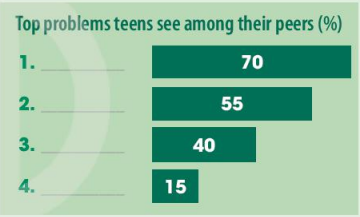Tiếng Anh 11 Unit 9 Communication and culture/ CLIL1. Listen and complete the conversation with the expressions in the box. Then practise it in pairs. 2. Work in pairs. Use the model in 1 to make similar conversations for these situations. One of you is Student A, the other is Student B. Use the expressions to help you. 1. Read the text and match each percentage in the chart with ONE social problem mentioned in the text. 2. Work in pairs. Discuss the following questions. GÓP Ý HAY - NHẬN NGAY QUÀ CHẤT Gửi góp ý cho HocTot.Nam.Name.Vn và nhận về những phần quà hấp dẫn
Lựa chọn câu để xem lời giải nhanh hơn
Everyday English 1 Video hướng dẫn giải Expressing disappointment and sympathy (Thể hiện sự thất vọng và đồng cảm) 1. Listen and complete the conversation with the expressions in the box. Then practise it in pairs. (Nghe và hoàn thành cuộc hội thoại với các biểu thức trong hộp. Sau đó thực hành nó theo cặp.) A. I can sympathise (Tôi có thể thông cảm) B. I'm sorry to hear that (Tôi rất tiếc khi nghe điều đó) C. What a pity (Thật đáng tiếc) Mary: I'm afraid I can’t go to the cinema with you, Andy. Andy: (1) ____________! I really wanted you to watch the film. Mary: Maybe another time. My brother is going to see a doctor tomorrow and I promised to go with him. Andy: (2) ____________. What's wrong with him? Mary: He's been bullied at school. We think he’s suffering from depression and needs help. Andy: (3) ____________. l was also the victim of bullying and had a very painful experience. I hope he'll be fine. Mary: Thank you for your sympathy, Andy. Lời giải chi tiết:
Mary: I'm afraid I can’t go to the cinema with you, Andy. (Tôi e rằng tôi không thể đi xem phim với bạn, Andy.) Andy: (1) C. What a pity! I really wanted you to watch the film. (Thật đáng tiếc! Tôi thực sự muốn bạn xem phim.) Mary: Maybe another time. My brother is going to see a doctor tomorrow and I promised to go with him. (Có thể để lúc khác. Anh trai tôi sẽ đi khám bác sĩ vào ngày mai và tôi đã hứa sẽ đi cùng anh ấy.) Andy: (2) B. I'm sorry to hear that. What's wrong with him? (Tôi rất tiếc khi nghe điều đó. Có chuyện gì với anh ấy vậy?) Mary: He's been bullied at school. We think he’s suffering from depression and needs help. (Anh ấy bị bắt nạt ở trường. Chúng tôi nghĩ rằng anh ấy đang bị trầm cảm và cần được giúp đỡ.) Andy: (3) A. I can sympathise. I was also the victim of bullying and had a very painful experience. I hope he'll be fine. (Tôi có thể thông cảm. Tôi cũng là nạn nhân của bắt nạt và đã có một kinh nghiệm rất đau đớn. Tôi hy vọng anh ấy sẽ ổn.) Mary: Thank you for your sympathy, Andy. (Cảm ơn sự thông cảm của bạn, Andy.) Everyday English 2 Video hướng dẫn giải 2. Work in pairs. Use the model in 1 to make similar conversations for these situations. One of you is Student A, the other is Student B. Use the expressions to help you. (Làm việc theo cặp. Sử dụng mô hình trong phần 1 để tạo các hội thoại tương tự cho các tình huống này. Một trong số các bạn là Học sinh A, người kia là Học sinh B. Sử dụng các biểu thức để giúp bạn.) 1. Student A can't go on a school trip because his/her littte brother/sister is ill and he/she has to take care of him/her. Student B expresses disappointment and sympathy. (Học sinh A không thể đi dã ngoại vì anh/chị/em bị ốm và phải có em chăm sóc. Học sinh B bày tỏ sự thất vọng và thông cảm.) 2. Student B can’t finish a community project on time because he/she is too stressed preparing for his/ner exams. Student A expresses disappointment and sympathy. (Học sinh B không thể hoàn thành dự án cộng đồng đúng hạn vì em ấy quá căng thẳng để chuẩn bị cho kỳ thi cuối kỳ. Học sinh A bày tỏ sự thất vọng và thông cảm.) Lời giải chi tiết: 1. A: I'm sorry, I can't go on the school trip with you. My little sister is ill and I have to take care of her. (Em xin lỗi, em không thể đi dã ngoại với bạn. Em gái em bị ốm và em phải chăm sóc em ấy.) B: Oh no! That's really disappointing. I was looking forward to going with you. Is your sister okay? (Ồ không! Điều đó thực sự đáng thất vọng. Tôi đã mong được đi với bạn. Em gái của bạn có ổn không?) A: She has a fever and needs to rest at home. I'm really worried about her. (Cô ấy bị sốt và cần nghỉ ngơi ở nhà. Tôi thực sự lo lắng cho cô ấy.) B: I'm sorry to hear that. I hope she gets better soon. (Tôi rất tiếc khi nghe điều đó. Tôi mong cô ấy sẽ mau khỏe.) 2. B: I'm sorry, I won't be able to finish the community project on time. I'm too stressed out preparing for my exams. (Tôi xin lỗi, tôi sẽ không thể hoàn thành dự án cộng đồng đúng hạn. Tôi quá căng thẳng khi chuẩn bị cho kỳ thi của mình.) A: Oh, that's too bad. I was counting on your help. How are your exams going? (Ồ, tệ quá. Tôi đã tin tưởng vào sự giúp đỡ của bạn. Làm thế nào là kỳ thi của bạn đi?) B: They're really tough. I've been studying for hours every day, but I still feel like I'm not ready. (Họ thực sự khó khăn. Tôi đã học hàng giờ mỗi ngày, nhưng tôi vẫn cảm thấy mình chưa sẵn sàng.) A: I can sympathize. I know how stressful exams can be. But don't worry, you'll get through it. (Tôi có thể thông cảm. Tôi biết các kỳ thi căng thẳng như thế nào. Nhưng đừng lo, bạn sẽ vượt qua được thôi.) B: Thank you for your support, it means a lot. (Cảm ơn sự hỗ trợ của bạn, nó có ý nghĩa rất lớn.) CLIL 1 Video hướng dẫn giải 1. Read the text and match each percentage in the chart with ONE social problem mentioned in the text. (Đọc văn bản và nối từng phần trăm trong biểu đồ với MỘT vấn đề xã hội được đề cập trong văn bản.) SOCIAL PROBLEMS FACING TEENS IN THE US TODAY In many countries around the world, it is not easy growing up because teens are dealing with many socialissues. A study carried out by a famous research centre in the US found out that the following were among the most serious ones. Anxiety and depression: Seven in ten teenagers considered them a serious problem among their peers. The main source of teenagers’ anxiety and depression was social pressure, such as the pressure to look good, to fit in social groups, and to be good at sport. Bullying: 55% said that bullying was a major problem for teenagers, and around 15% admitted that they had experienced some form of cyberbullying. Girls or younger students were more likely to be victims of bullying. Poverty: Four out of 10 teens said that poverty was also a major problem for them. In fact, about 20% of the teens in the survey struggled to live below the poverty line every day. The survey results suggest that more support should be provided to help teenagers avoid serious social issues and enjoy a happier life. Phương pháp giải: Tạm dịch: CÁC VẤN ĐỀ XÃ HỘI MÀ THANH THIẾU NIÊN MỸ NGÀY NAY ĐỐI MẶT Ở nhiều quốc gia trên thế giới, trưởng thành không hề dễ dàng vì thanh thiếu niên phải đối mặt với nhiều vấn đề xã hội. Một nghiên cứu được thực hiện bởi một trung tâm nghiên cứu nổi tiếng ở Hoa Kỳ đã phát hiện ra rằng những điều sau đây là một trong những điều nghiêm trọng nhất. Lo lắng và trầm cảm: Cứ 10 thanh thiếu niên thì có 7 người coi chúng là một vấn đề nghiêm trọng với bạn bè đồng trang lứa. Nguyên nhân chính khiến thanh thiếu niên lo lắng và trầm cảm là do áp lực xã hội, chẳng hạn như áp lực phải có ngoại hình ưa nhìn, phải phù hợp với các nhóm xã hội và phải giỏi thể thao. Bắt nạt: 55% nói rằng bắt nạt là một vấn đề lớn đối với thanh thiếu niên và khoảng 15% thừa nhận rằng họ đã trải qua một số hình thức bắt nạt trên mạng. Các em gái hoặc học sinh nhỏ tuổi có nhiều khả năng trở thành nạn nhân của bắt nạt hơn. Nghèo đói: Cứ 10 thanh thiếu niên thì có 4 người nói rằng nghèo đói cũng là một vấn đề lớn đối với họ. Trên thực tế, khoảng 20% thanh thiếu niên trong cuộc khảo sát phải vật lộn để sống dưới mức nghèo khổ mỗi ngày. Kết quả khảo sát cho thấy cần hỗ trợ nhiều hơn để giúp thanh thiếu niên tránh các vấn đề xã hội nghiêm trọng và tận hưởng cuộc sống hạnh phúc hơn. Lời giải chi tiết: Top problems teens see among their peers (%) (Những vấn đề hàng đầu mà thanh thiếu niên gặp phải ở bạn bè đồng trang lứa (%)) 1. Anxiety and depression: 70% (Lo lắng và trầm cảm: 70%) 2. Bullying: 55% (Bắt nạt: 55%) 3. Poverty: 40% (Nghèo đói: 40%) 4. Cyberbullying: 15% (Bắt nạt trên mạng: 15%) CLIL 2 Video hướng dẫn giải 2. Work in pairs. Discuss the following questions. (Làm việc theo cặp. Thảo luận các câu hỏi sau.) Are the problems mentioned in the text similar to those facing Vietnamese teens? (Những vấn đề được đề cập trong văn bản có giống với những vấn đề mà thanh thiếu niên Việt Nam đang phải đối mặt không?) Are there any other problems among teenagers in Viet Nam? (Có bất kỳ vấn đề nào khác trong thanh thiếu niên ở Việt Nam không?) Lời giải chi tiết: There are similarities between the problems facing teens in many countries, including Vietnam. Cyberbullying, academic pressure, social pressure, mental health issues, substance abuse, and poverty are some of the issues that Vietnamese teens may face. In addition to the problems mentioned in the text, there may be other problems among teenagers in Vietnam. For example, issues related to family relationships, dating and sexuality, career choices, and cultural conflicts are also common. It is important for parents, educators, and society as a whole to pay attention to the needs of teenagers and provide them with adequate support and resources to help them navigate these challenges. Tạm dịch: Có những điểm tương đồng giữa các vấn đề mà thanh thiếu niên ở nhiều quốc gia phải đối mặt, trong đó có Việt Nam. Bắt nạt trên mạng, áp lực học hành, áp lực xã hội, các vấn đề sức khỏe tâm thần, lạm dụng chất kích thích và nghèo đói là một số vấn đề mà thanh thiếu niên Việt Nam có thể gặp phải. Ngoài những vấn đề được đề cập trong văn bản, có thể có những vấn đề khác trong thanh thiếu niên ở Việt Nam. Ví dụ, các vấn đề liên quan đến mối quan hệ gia đình, hẹn hò và tình dục, lựa chọn nghề nghiệp và xung đột văn hóa cũng rất phổ biến. Điều quan trọng đối với các bậc cha mẹ, các nhà giáo dục và toàn xã hội là phải chú ý đến nhu cầu của thanh thiếu niên và cung cấp cho họ sự hỗ trợ và nguồn lực đầy đủ để giúp họ vượt qua những thách thức này.
>> 2K9 Học trực tuyến - Định hướng luyện thi TN THPT, ĐGNL, ĐGTD ngay từ lớp 11 (Xem ngay) cùng thầy cô giáo giỏi trên Tuyensinh247.com. Bứt phá điểm 9,10 chỉ sau 3 tháng, tiếp cận sớm các kì thi.
|






















